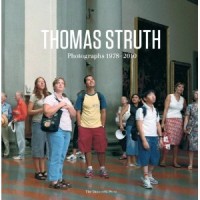
Thomas Struth is one of Europe’s most exhibited and collected photographers. I got myself pretty excited about reviewing this offering from the Monacelli Press that showcases several of his series of work: cityscapes, family portraits, images of science and technology, museum photos, and nature pictures. There are also some essays examining Struth’s work. This is one hefty book. Does it live up to its weight?
I have a soft-spot for cityscapes and architectural photography. Why? I don’t know why. Why do I prefer lemon ice cream to vanilla and why don’t I like chocolate at all? But Struth’s cityscapes left me cold. What was I looking at? What was he trying to convey with his perfectly centred images of tower blocks? I’m really not sure. Nothing in these pictures, to me, conveyed the sense of place, the interaction of the people who live and work there, any feeling of vibrancy. They were just images of tower blocks. (Albeit one of them is in Pyongyang, which I thought was impressive.)
These empty and cold cityscapes did form an interesting juxtaposition with his images of museums and places of worship. These photos are full, busy. They depict school groups looking bored in the Louvre and people eating their lunch on the steps outside the Duomo in Milan. It’s not how you expect to see these places photographed, and that in itself is thought-provoking.
The images of science and technology are interesting, but they are not exactly anything that I’d be rushing to hang on my wall. In some instances they make good documentations of places or things, but that isn’t what I expect from fine art photography. It just a bit too, well, mundane, for me.
Struth’s famed for his family portraits and I was hoping that they would elevate my enjoyment of the book. Supposedly, he uses them to explore underlying social dynamics. Maybe I was missing something, but they looked pretty much like family portraits to my eye. I couldn’t detect whatever statement it was that Struth was trying to make.
So did the essays clarify anything for me? I thought that I was going to drown in the gushing hyperbole that one of them was spewing forth like an over-active geyser. They somehow managed to leave me feeling somehow inferior for not appreciating Struth’s work. That probably wasn’t the aim, but it was the outcome.
As a book, it’s a beautiful presentation of Struth’s work. If you like his photography, you’ll relish it. But what if Struth’s photography doesn’t set your heart racing and you struggle to connect with it? It’s one of those books that you’ll feel that you ought to like, but just can’t bring yourself to. It’s one of what my brother – who’s a musician – and I refer to as our ‘innocent pains’. My brother has Bach. It seems as if I now have Thomas Struth to add to Die Zauberflöte.
Thomas Struth Photographs 1978-2010. Published by The Monacelli Press and available from Amazon UK and Amazon US.
